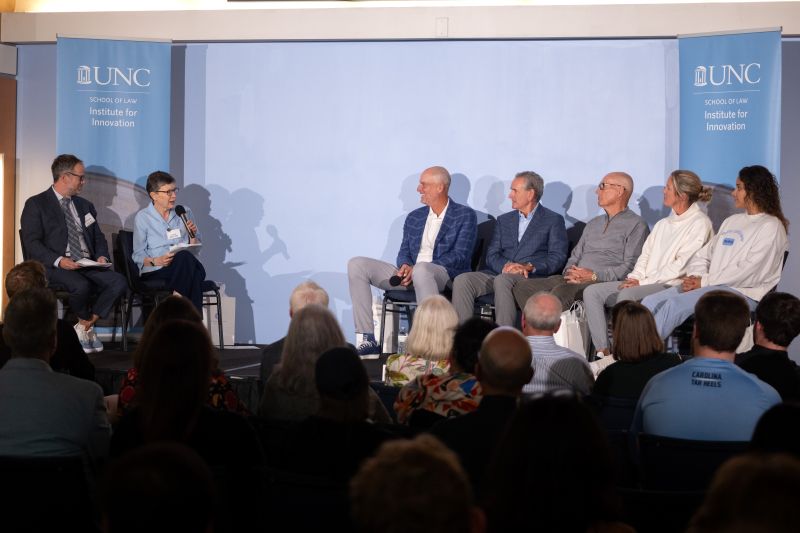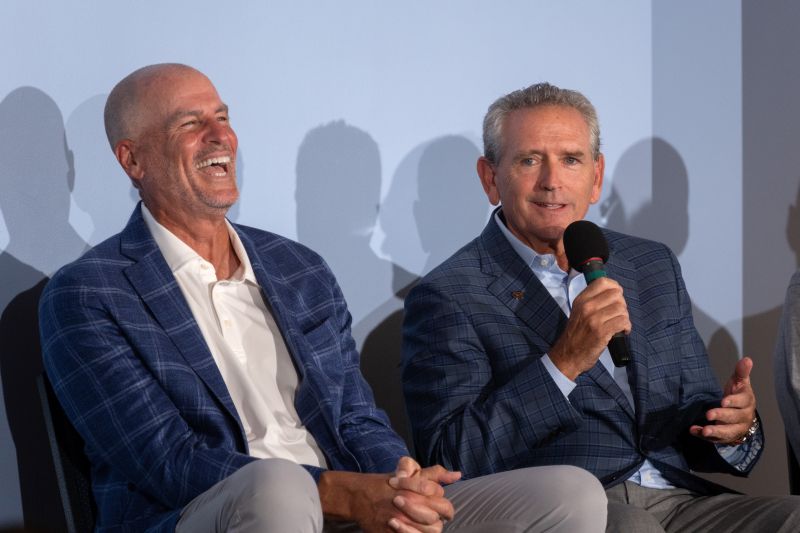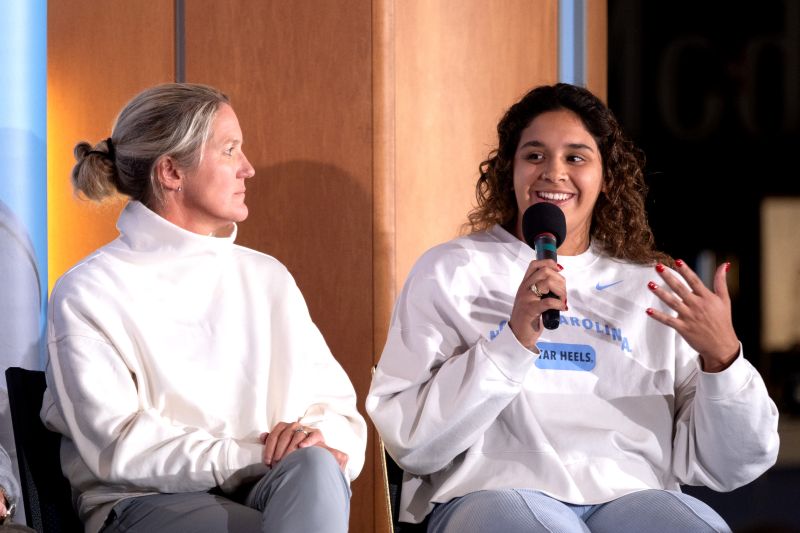By: Aaron Gard, executive director for the Institute for Innovation

The Blue Zone at Kenan Stadium buzzed with anticipation as over 250 attendees filed in for the UNC School of Law Institute for Innovation’s latest event. On Oct. 1, 2024, the Institute assembled a panel to dissect “The Future of College Athletics,” cementing the Institute’s role in shaping critical conversations on current legal matters impacting society in North Carolina and beyond.
As the event began, the star-studded lineup took their seats: UNC Women’s Basketball coach Courtney Banghart; ESPN basketball analyst and attorney Jay Bilas; UNC-Chapel Hill Director of Athletics Bubba Cunningham; former Big Ten Conference commissioner and Carolina Law alumnus Jim Delany ’73; and Olympic diver and Carolina student athlete Aranza Vázquez.
Aaron Gard, executive director of the Institute for Innovation, kicked off the event. “Where there is chaos, there is opportunity,” he declared. “And there is a lot of chaos right now in college athletics, which leads to opportunity, particularly for smart legal minds.” His words launched an evening of candid debate and bold ideas.
The conversation centered on the changing landscape of college athletics, which has been particularly jam-packed with legal issues over the last few years. The panel discussed topics ranging from antitrust, to collective bargaining, to conference realignment, and far more.

The panel dove into one of college sports’ recent monumental changes, the establishment of Name, Image, and Likeness rights, which now permit college athletes to earn money from their personal brands through sponsorships, advertisements and other business deals. Cunningham explained how UNC Athletics is helping its athletes navigate the changing landscape.
Delany traced a legal journey that continues to reshape the foundation of college sports. He discussed the 1984 and 2021 landmark United States Supreme Court cases involving the NCAA. In 1984, the Supreme Court ruled in NCAA v. Board of Regents of the University of Oklahoma that the NCAA’s television plan violated antitrust laws. The court found that the NCAA’s plan restricted trade and output and was illegal under the Sherman Act. In 2021, the Supreme Court ruled unanimously in NCAA v. Alston that the NCAA’s compensation rules violated the Sherman Act when they restricted non-cash, education-related benefits, such as post-eligibility undergraduate or graduate scholarships or tutoring, study abroad expenses and paid post-eligibility internships.
Though the 1984 Supreme Court still saw some merit in NCAA rules, Delany explained how the Alston ruling marked a seismic shift. The Court no longer accepted the NCAA’s arguments about preserving amateurism. With Name, Image and Likeness rights following soon after, schools and conferences gained unprecedented freedom to pursue commercial opportunities for their athletes.
Bilas broke down House v. NCAA, which includes the landmark $2.78 billion settlement of three separate antitrust cases facing the NCAA and power conferences. Judge Claudia Wilken in the Northern District of California approved the settlement, clearing the way for schools to begin paying players directly through revenue sharing, starting in 2025. The hearing on final approval of the settlement is currently scheduled for April 2025.
Bilas predicted the House case could finally force the NCAA to abandon its resistance to athlete compensation. The proposed settlement suggests athletes could receive 22% of athletic revenues going forward — a change Bilas sees as inevitable. “We’re going to get used to this pretty quick,” he argued, dismissing concerns about paying players. “It’s amazing how we can pay everybody else just fine, and the business runs just fine, but we can’t figure out how to pay the athletes.”
These developments raised urgent questions about Title IX compliance. Delany explained how the 1972 law, which mandates gender equity in education, has grown teeth depending on who runs the Department of Education. As schools face the prospect of paying athletes directly, they’ll need to ensure fair treatment across men’s and women’s sports. This challenge could reshape how revenues are distributed throughout athletic departments.

The debate heated up around conference realignment and the ACC’s westward expansion to the University of California, Berkley; Stanford University; and Southern Methodist University. Vázquez cut through the politics to voice student athletes’ real fears. As a member of UNC-Chapel Hill’s swimming and diving team, which has 70-80 athletes, she raised practical concerns about coordinating cross-country travel for large teams. “The biggest concern is how many days of classes we’re losing,” she explained. Though she has communicated well with her professors about missing classes, she is concerned that frequent travel could negatively affect her academic performance.
The concerns about the growing demands on student athletes led Cunningham to a stark prediction about the future: college sports will see more money but fewer athletes and teams. Yet for those who remain, he envisions better compensation and opportunities that could help offset the increasing pressures of competing at the highest level.
In addition to the panelists on stage, the event drew heavy hitters like Rick Evrard, the collegiate sports practice co-head at Bond, Schoeneck & King, and former North Carolina State University athlete Peyton Barish, who is now with the Knight Commission on Intercollegiate Athletics.
For the students in attendance, the event provided valuable insights into the complex world of sports law and potential career paths in this evolving field. Attendee and retired UNC Kenan-Flagler Business School Dean Jack Evans remarked, “The panel was very timely and quite well done. Kudos for recruiting the participants, preparing the agenda and guiding the dialogue.”
The “Future of College Athletics” discussion was about change, and as the dust settles on the event, one thing is clear: the UNC School of Law Institute for Innovation brings people together to talk about relevant legal issues impacting North Carolina and beyond.



